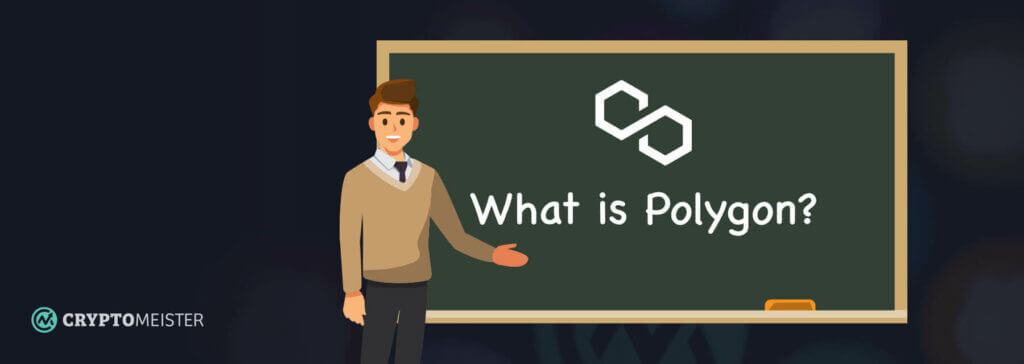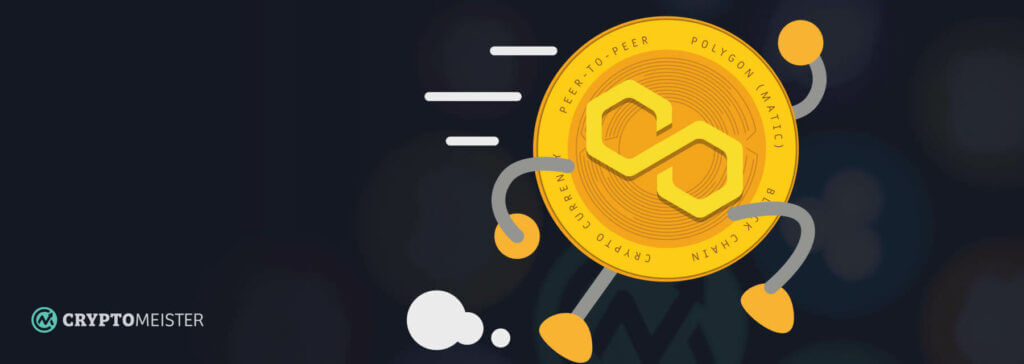
Binance
Only for verified users
Polygon was started in 2017 when The “MATIC Network” project was launched by several software engineers, and is currently in the top 10 when looking at market cap for all cryptos. Discover Polygon and learn everything you need to know with our detailed guide. We also list the best crypto exchanges where you can buy Polygon!

Only for verified users


Polygon is a blockchain that has seemingly come out of nowhere to become one of the seriously big players in the crypto space. The Ethereum-based protocol has landed partnerships that others can only dream of, including Starbucks, Mercedes and Robinhood, and it doesn’t look like it’s going to stop there.
But what does this Ethereum-killer have under the hood that is sending household names flocking to it to fulfill their Web 3.0 dreams, and should it be enough to make you go out and buy MATIC tokens, the cryptocurrency of the Polygon project? Let’s find out.

Polygon was founded as ‘Matic’ in 2017 when Jaynti Kanani, a data scientist, spotted what many at the time had also spotted at that time in the crypto space – Ethereum could not cope with the demands placed upon it.
This was at the time of the ICO boom, which led to ‘gas wars’ whenever ICOs opened their doors for contributions, and the first big NFT project, Cryptokitties, exposing the issues inherent in the clogged blockchain.
Realizing the space was ripe for change, Kanani got in touch with Sandeep Nailwal, a blockchain developer, and Anurag Arjun, a business consultant.
Together, the trio took all the best bits of Ethereum and built a much faster platform around it, allowing Ethereum projects to bridge over to it and experience life on the open road, with transaction costs massively reduced compared to its aging cousin.
The name ‘Matic’ referred to ‘automatic’, which summarizes the nature of the smart contracts that Ethereum is famous for creating, but in February 2021 the Matic team announced a rebrand to Polygon.
This, they said at the time, reflected the new, expanded focus of the platform, to create a multi-chain system, incorporating other Ethereum scaling solutions such as Optimistic Rollups, ZkRollups and StarkWare’s Validium.
This would turn it into a complete layer 2 scaling solution, capable of supporting cryptocurrencies, NFTs, metaverse experiences and more.
Polygon has seen huge adoption as a result of its new drive, with billionaire Mark Cuban investing into the project in 2021 and the likes of Starbucks, Mercedes and Meta all using the platform for their Web 3.0 endeavors, showing that the work is certainly paying off so far.

MATIC has become a very popular coin in the crypto space, available on many exchanges and other platforms. Here is a rundown of where you can buy MATIC:
MATIC is available on hundreds of centralized exchanges (CEXs), including several large ones such as Binance, Kucoin and Coinbase. CEXs allow you to buy MATIC with fiat currency from your bank or swap another cryptocurrency for it, although you will need to register with a government-approved ID first.
One benefit of using a CEX is that you can put in a ‘buy’ order at a lower price if you think the price is going to drop, meaning you can potentially pick up more MATIC for the same dollar value.
You can also very clearly see the orderbook, meaning there is no risk of your order failing or experiencing unexpected slippage. This can happen on a DEX where there is not enough MATIC in the ‘pool’ to fill demand at your price, so it begins to take coins at a higher price.
The downside of using a CEX is that the exchange holds your coins, not you, increasing the risk of loss.
MATIC is also available from top decentralized exchanges (DEXs) such as Uniswap, which only accept other cryptocurrencies in return.
You will need a compatible cryptocurrency already in a wallet in order to swap on a DEX, so make sure you know which coins your DEX allows you to swap MATIC for before you go about it. DEXs offer more privacy because you don’t need to register – just connect your wallet and you’re away.
DEXs tend to have a more simple interface, making them appealing to newcomers, but if something goes wrong, such as potential slippage, then it can be quite tricky to know how to fix it. And with a DEX, you’re on your own – no customer service.
The Polygon bridge, which you can find in the Polygon Wallet Suite, allows you to swap one of a large number of cryptocurrencies quickly and easily into MATIC at the going rate. This is a little like using a DEX, except all coins lead to MATIC. Again, you’ll need to know which coins you can swap into MATIC before you start, and make sure you have them in a compatible wallet.
There are a number of ways you can buy MATIC tokens and pay for them, but here are the the most common ones:
If you already hold cryptocurrencies in a wallet, you’re spoilt for choice with the options available to you. You can either swap them for MATIC on the Polygon bridge or on a DEX using just the wallet itself, or you can send them over to CEX and swap them there.
Cryptocurrencies are much more private than swapping with fiat currencies, with fewer restrictions.
Many CEXs allow their users to buy MATIC coins with a credit card or debit card, as long as their bank supports crypto purchases, which not all do. Buying MATIC tokens this way is very similar to buying anything online, but you may well need to verify the purchase through your bank before it is processed.
Once you have registered/logged into your CEX, simply click or tap the ‘buy’ option. This is typically located on the exchange’s homepage, so you can’t miss it. Enter the fiat value of the MATIC you want to buy and go through the steps to complete the payment (beware of processing fees). Once your MATIC purchase has been approved, it is advisable to withdraw it from the exchange to your wallet, but this is not essential.
Not all banks allow cryptocurrency purchases through their cards, but there is another way – bank transfers. Many of the top CEXs allow you to fund your account through a bank deposit which typically doesn’t carry the same restrictions. This process involves sending your funds over to the exchange through a standard bank transfer and buying the coins once your account has been credited.
If you need to do things this way, it’s best to perform a small test transfer to make sure it goes through before sending the full amount. This way, if anything is amiss you aren’t in a critical situation. If you sell your MATIC tokens and want to withdraw the resulting fiat from the exchange, you will be able to send it back to this account again.
Polygon is able to offer fast transactions (typically 4,000-10,000 per second) thanks to the suite of different protocols it uses under the hood, including the zero-knowledge (zk) proof variety, meaning developers are not just stuck with one scaling solution – they can choose the best one that suits them.
Zk proofs are a cryptographic tool used for verifying to another party whether a particular statement (for example a transaction amount) is valid. The prover is not required to provide any additional information, other than the fact that the statement is true, ensuring a high level of privacy for all parties.
Polygon operates on ‘sidechains’, a term most commonly associated with another cryptocurrency platform, Polkadot. These are versions of blockchains that run alongside the main chain, taking pressure off it and allowing multiple transactions to take place across all sidechains and the main chain at once. This is compared to Ethereum’s linear blockchain, which processes transactions in order of request on one chain.
One of the most popular sidechains Polygon employs is called the ‘plasma chain’. In this instance, Ethereum is the ‘primary’ or ‘parent’ blockchain, which Plasma chains link up to and communicates with, allowing assets to transfer between them securely.
Following high demand from developers, Polygon introduced a blockchain bridge in August 2022. This bridge allows developers to create decentralized applications (Dapps) on one platform without having to sacrifice the benefits afforded by others.
Polygon knows that there is no single ideal solution that will accommodate all applications on its network, with each scaling solution coming with tradeoffs between security, sovereignty, transaction fees and transaction speed.
It is therefore down to developers to select the solution that is most suitable for their needs, but the fact that developers can do all this on Ethereum and all under the Polygon name is a core reason why it is proving so popular with creators of games, DeFi projects, NFTs, and metaverse platforms.
MATIC is the native cryptocurrency of the Polygon blockchain, and is used to complete all transactions on the Polygon plasma chains. This means that anyone using products or services on Polygon will pay a little MATIC as ‘gas’ to push the transaction through.
In 2022, the average gas price was higher than in previous years thanks to greater adoption, but between January and September it still averaged out at around $0.018.
Another reason that crypto enthusiasts might want to buy MATIC tokens is because they can stake them to earn rewards. MATIC relies on token holders to act as validators for transactions (we’ll explain this a bit more later on), but the benefit of this is that anyone who does so earns MATIC tokens as a reward.
This can be done on exchanges or solo, the latter of which is better from a security perspective, and the great thing about this is that anyone can start staking by locking up just 1 MATIC token. The more you lock up, the higher your reward rate.
Holding MATIC tokens also affords you governance rights. If a proposal is put forward to change a part of the Polygon network, MATIC holders can vote on it. This ensures that decisions are taken democratically, which is essential in a decentralized system.

You can use a Polygon wallet to store and, in many instances, stake your MATIC tokens. The official Polygon wallet suite isn’t exactly a wallet itself, but more of a portal that lets you interact with MATIC.
To access it you’ll need another cryptocurrency wallet (the suite accepts five different ones, including popular ones such as MetaMask and Walletconnect). These are known as ‘software wallets’ as they are pieces of software that sit on a computer or mobile device in the form of an app.
You can also store (and often stake) your MATIC tokens in a hardware wallet. These look like USB keys and store your MATIC tokens offline for ultimate security.
The top models have also recently introduced staking options, which means you’re not missing out on rewards by using them. Whereas software wallets are free, hardware wallets are not, but they are more secure.

Polygon runs on a Proof-of-Stake (PoS) blockchain, the kind that Ethereum switched to in September 2022, but with its own twist. Polygon functions primarily through ‘Commit chains’, which are networks that operate adjacent to the main blockchain, which in Polygon’s case is Ethereum.
The Commit chains bundle batches of transactions together and confirm them in groups before returning data to the main chain, eliminating the need for Ethereum to process all the data on its own. By batching transactions off the main chain in this way, Polygon makes using Ethereum lighter and faster.
Polygon uses Validators and Delegators to process transactions. Validators are people who run a piece of software on their computers 24/7 and who each store a copy of the Polygon blockchain which is updated with every block added to it. Validator nodes are responsible for processing transactions and creating new blocks.
Delegators on the other hand are regular individuals holding at least 1 MATIC tokens and who ‘delegate’ their tokens to a Validator. When that Valildator is chosen to process transactions or create a block, the reward is shared between the Delegators, with the reward proportional to the amount of MATIC locked up.
Validators are chosen based on the amount and duration of their MATIC lockup. This means that delegating to a large Valildator gives you more chance of being chosen but a more diluted reward, whereas being part of a smaller pool has the opposite impact.
While Polygon certainly has a lot going for it, there are a couple of things to be careful of before you go out and buy MATIC tokens.
Firstly is potential vulnerabilities. Polygon is a very complex protocol, with numerous elements all working in tandem, and as such there will be unforeseen issues.
This was highlighted in December 2021 when a pair of ‘white hat’ hackers found a critical vulnerability in the protocol that put the entire supply of MATIC tokens, worth $24 billion at the time, at risk. Fortunately the discoverers informed Polygon about it and didn’t use the flaw for personal gain, but this is an example of how huge issues can lay dormant.
Secondly, Ethereum’s migration to a PoS consensus mechanism represents a new challenge to Polygon. Polygon was introduced because Ethereum couldn’t scale, but now it has begun to do just that, with its own on-chain scaling operations set to rollout in 2023.
Ethereum is still the biggest name in the crypto space for smart contracts, and if it can begin to compete with Polygon in terms of throughput and transaction costs, many developers will choose to build on Ethereum because of its existing reputation.
Polygon doesn’t have an official roadmap so it’s hard to know what it has up its sleeve, but with Ethereum threatening to take back some of the thunder that Polygon has stolen with its big partnerships, it’s now more important than ever that Polygon developers don’t let their advantage slip.
The launch of the Polygon Bridge was an important move in terms of interoperability, and it is likely that as time passes it will be made easier to jump between the different chains that form Polygon. There will of course be other updates rolled out over the coming months and years, but it seems we will have to wait to see what these are.
Polygon has come out of nowhere to become the biggest challenger to Ethereum’s crown as smart contract king.
The fact that it is hosting Starbucks’ metaverse platform, Mercedes’ data sharing protocol and the Robinhood crypto wallet, plus the fact that it was chosen as one of six companies selected to participate in Disney’s 2022 Accelerator program, shows the esteem in which it is currently held.
Of course, whether all this translates into appreciation in value of the MATIC token remains unknown. Even these partnerships haven’t managed to protect it from the ravages of a bear market, but it is a factor of utility tokens that unless demand outweighs supply, the value will not necessarily increase in the long term.
However, in many ways the aim of the crypto game is survival, and with such big partnerships and impressive tech, it’s clear that Polygon can now be considered a giant in the crypto space and a serious threat to Ethereum’s hegemony.